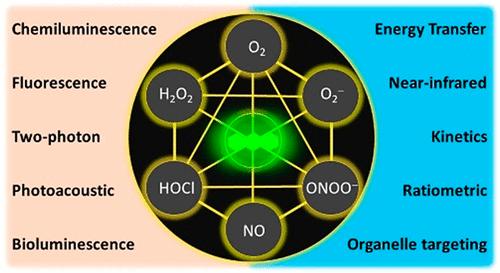当前位置:
X-MOL 学术
›
Chem. Rev.
›
论文详情
Our official English website, www.x-mol.net, welcomes your
feedback! (Note: you will need to create a separate account there.)
Ex Tenebris Lux: Illuminating Reactive Oxygen and Nitrogen Species with Small Molecule Probes
Chemical Reviews ( IF 51.4 ) Pub Date : 2024-08-13 , DOI: 10.1021/acs.chemrev.3c00892 Maidileyvis C Cabello 1 , Gen Chen 1 , Michael J Melville 2 , Rokia Osman 1 , G Dinesh Kumar 2 , Dylan W Domaille 2 , Alexander R Lippert 1
Chemical Reviews ( IF 51.4 ) Pub Date : 2024-08-13 , DOI: 10.1021/acs.chemrev.3c00892 Maidileyvis C Cabello 1 , Gen Chen 1 , Michael J Melville 2 , Rokia Osman 1 , G Dinesh Kumar 2 , Dylan W Domaille 2 , Alexander R Lippert 1
Affiliation

|
Reactive oxygen and nitrogen species are small reactive molecules derived from elements in the air─oxygen and nitrogen. They are produced in biological systems to mediate fundamental aspects of cellular signaling but must be very tightly balanced to prevent indiscriminate damage to biological molecules. Small molecule probes can transmute the specific nature of each reactive oxygen and nitrogen species into an observable luminescent signal (or even an acoustic wave) to offer sensitive and selective imaging in living cells and whole animals. This review focuses specifically on small molecule probes for superoxide, hydrogen peroxide, hypochlorite, nitric oxide, and peroxynitrite that provide a luminescent or photoacoustic signal. Important background information on general photophysical phenomena, common probe designs, mechanisms, and imaging modalities will be provided, and then, probes for each analyte will be thoroughly evaluated. A discussion of the successes of the field will be presented, followed by recommendations for improvement and a future outlook of emerging trends. Our objectives are to provide an informative, useful, and thorough field guide to small molecule probes for reactive oxygen and nitrogen species as well as important context to compare the ecosystem of chemistries and molecular scaffolds that has manifested within the field.
中文翻译:

Ex Tenebris Lux:用小分子探针照亮活性氧和氮物种
活性氧和活性氮是源自空气中的元素(氧和氮)的小活性分子。它们是在生物系统中产生的,用于介导细胞信号传导的基本方面,但必须非常严格地平衡,以防止对生物分子的不加区别的损害。小分子探针可以将每种活性氧和氮的特定性质转化为可观察的发光信号(甚至声波),从而在活细胞和整个动物中提供灵敏和选择性的成像。本综述特别关注提供发光或光声信号的超氧化物、过氧化氢、次氯酸盐、一氧化氮和过氧亚硝酸盐的小分子探针。将提供有关一般光物理现象、常见探针设计、机制和成像方式的重要背景信息,然后对每种分析物的探针进行彻底评估。将讨论该领域的成功,然后提出改进建议和新兴趋势的未来展望。我们的目标是为活性氧和氮物种的小分子探针提供信息丰富、有用且全面的现场指南,并为比较该领域内出现的化学生态系统和分子支架提供重要背景。
更新日期:2024-08-13
中文翻译:

Ex Tenebris Lux:用小分子探针照亮活性氧和氮物种
活性氧和活性氮是源自空气中的元素(氧和氮)的小活性分子。它们是在生物系统中产生的,用于介导细胞信号传导的基本方面,但必须非常严格地平衡,以防止对生物分子的不加区别的损害。小分子探针可以将每种活性氧和氮的特定性质转化为可观察的发光信号(甚至声波),从而在活细胞和整个动物中提供灵敏和选择性的成像。本综述特别关注提供发光或光声信号的超氧化物、过氧化氢、次氯酸盐、一氧化氮和过氧亚硝酸盐的小分子探针。将提供有关一般光物理现象、常见探针设计、机制和成像方式的重要背景信息,然后对每种分析物的探针进行彻底评估。将讨论该领域的成功,然后提出改进建议和新兴趋势的未来展望。我们的目标是为活性氧和氮物种的小分子探针提供信息丰富、有用且全面的现场指南,并为比较该领域内出现的化学生态系统和分子支架提供重要背景。


















































 京公网安备 11010802027423号
京公网安备 11010802027423号